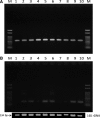Dynamic integration and excision of filamentous phage XacF1 in Xanthomonas citri pv. citri, the causative agent of citrus canker disease
- PMID: 29123980
- PMCID: PMC5666396
- DOI: 10.1002/2211-5463.12312
Dynamic integration and excision of filamentous phage XacF1 in Xanthomonas citri pv. citri, the causative agent of citrus canker disease
Abstract
Inovirus XacF1 (7325 nucleotides) is integrated into the genome of Xanthomonas citri pv. citri (Xcc) strains at the host dif site (attB) by the host XerC/D recombination system. The XacF1 attP sequence is located within the coding region of ORF12, a possible phage regulator. After integration, this open reading frame (ORF) is split into two pieces on the host genome. We examined dynamic integration/excision of XacF1 in Xcc strain MAFF 301080 and found that the integration started at 4 h postinfection (p.i.) and peaked at 12 h p.i. Thereafter, the ratio of integrated to free forms remained constant, suggesting equilibrium of integration and excision of XacF1 in the host genome. However, the integrated state became very unstable following a 5'-deletion of ORF12 in XacF1, suggesting that ORF12 plays a key role in the integration cycle of XacF1 in Xcc strains.
Keywords: XerC/D; biocontrol; citrus canker; filamentous phage; integration mechanism.
Figures




Similar articles
-
The filamentous phage XacF1 causes loss of virulence in Xanthomonas axonopodis pv. citri, the causative agent of citrus canker disease.Front Microbiol. 2014 Jul 1;5:321. doi: 10.3389/fmicb.2014.00321. eCollection 2014. Front Microbiol. 2014. PMID: 25071734 Free PMC article.
-
Complete nucleotide sequence of a new filamentous phage, Xf109, which integrates its genome into the chromosomal DNA of Xanthomonas oryzae.Arch Virol. 2017 Feb;162(2):567-572. doi: 10.1007/s00705-016-3105-3. Epub 2016 Oct 14. Arch Virol. 2017. PMID: 27743252
-
XerD-dependent integration of a novel filamentous phage Cf2 into the Xanthomonas citri genome.Virology. 2020 Sep;548:160-167. doi: 10.1016/j.virol.2020.06.010. Epub 2020 Jun 23. Virology. 2020. PMID: 32838937
-
Plasmids carrying cloned fragments of RF DNA from the filamentous phage (phi)Lf can be integrated into the host chromosome via site-specific integration and homologous recombination.Mol Genet Genomics. 2001 Nov;266(3):425-35. doi: 10.1007/s004380100532. Mol Genet Genomics. 2001. PMID: 11713672
-
Mechanistic insights into filamentous phage integration in Vibrio cholerae.Front Microbiol. 2014 Nov 28;5:650. doi: 10.3389/fmicb.2014.00650. eCollection 2014. Front Microbiol. 2014. PMID: 25506341 Free PMC article. Review.
Cited by
-
Evaluation of Bacterial Perpetuation Assays and Plant Biomolecules Antimicrobial Activity against Cotton Blight Bacterium Xanthomonas citri subsp. malvacearum; An Alternative Source for Food Production and Protection.Plants (Basel). 2022 May 10;11(10):1278. doi: 10.3390/plants11101278. Plants (Basel). 2022. PMID: 35631704 Free PMC article.
-
Isolation and characterization of vB_XciM_LucasX, a new jumbo phage that infects Xanthomonas citri and Xanthomonas fuscans.PLoS One. 2022 Apr 14;17(4):e0266891. doi: 10.1371/journal.pone.0266891. eCollection 2022. PLoS One. 2022. PMID: 35421196 Free PMC article.
-
Filamentous phages: masters of a microbial sharing economy.EMBO Rep. 2019 Jun;20(6):e47427. doi: 10.15252/embr.201847427. Epub 2019 Apr 5. EMBO Rep. 2019. PMID: 30952693 Free PMC article. Review.
References
-
- Civerolo EL (1984) Bacterial canker disease of citrus. J Rio Grande Val Hort Soc 37, 127–145.
-
- Gottwald TR, Graham JH and Schubert TS (2002) Citrus canker: the pathogen and its impact. Plant Health Prog. https://doi.org/10.1094/PHP-2002-0812-01-RV. - DOI
-
- Graham J, Gottwald T, Cubero J and Achor D (2004) Xanthomonas axonopodis pv. citri: factors affecting successful eradication of citrus canker. Mol Plant Pathol 5, 1–15. - PubMed
-
- da Silva AC, Ferro JA, Reinach FC, Farah CS, Furlan LR, Quaggio RB, Monteiro‐Vitorello CB, Van Sluys MA, Almeida NF, Alves LM et al (2002) Comparison of the genomes of two Xanthomonas pathogens with differing host specificities. Nature 417, 459–463. - PubMed
-
- Van Sluys MA, Monteiro‐Vitorello CB, Camargo LE, Menck CF, da Silva AC, Ferro JA, Oliveira MC, Setubal JC, Kitajima JP and Simpson AJ (2002) Comparative genomic analysis of plant‐associated bacteria. Annu Rev Phytopathol 40, 169–189. - PubMed
LinkOut - more resources
Full Text Sources
Other Literature Sources

